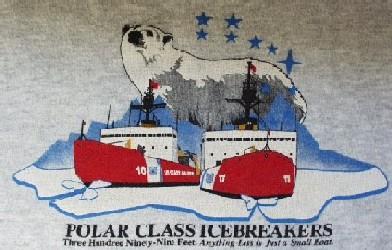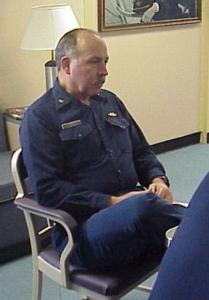
|
|
25 June, 2000
25 June 2000
Breaking The Ice
As mentioned in previous journals, the USCGC Healy is but the latest in a
proud line of icebreakers in the United States Coast Guard. On this leg of
the science testing, CDR George Dupree, Chief of Icebreaking Division at
USCG Headquarters in Washington, DC, is on board the HEALY. He oversees the
Polar Icebreaking Program, which includes the USCGCs Polar Sea, Polar Star,
and now, Healy. He is also responsible for the domestic icebreaking program
which keeps the Great Lakes ship lanes open for all but the middle of
winter, and the East Coast shipping lanes clear year-round. Were it not for
the Coast Guard’s efforts, many people and businesses in New England would
not get the fuel they need during the winter. A third realm of CDR Dupree’s
responsibilities is the International Ice Patrol. This program, begun as a
result of the Titanic disaster, identifies daily the locations and limits of
iceberg fields through the use of C130 aircraft flights. These planes are
equipped with Side-looking airborne radar (SLAR) and Forward-looking
airborne radar (FLAR) to help them locate and map these dangers to
navigation. The ice patrol’s efforts improve the safety of travel in areas
subject to bergs as well as improve transit time for ships trying to avoid
them.
CDR Dupree served on the USCGC Icebreaker Glacier in the early 1980’s
before spending six years in law enforcement on patrol boats and shore
operations in San Diego and Puerto Rico. From 1991-95 he worked at
Headquarters in Personnel, before he returned to an icebreaker, the USCGC
Polar Star, where he served for two years as Executive Officer (XO). He has
been Chief of the Icebreaking Program since 1997.
The Icebreakers themselves have had varied roles in the past. One of the
“Polars” as the Sea and Star are referred to, is involved in “Deep Freeze”
each year. The annual resupply of McMurdo Station in Antarctica involves a
tanker with fuel oil, and a fully loaded container ship, both with hulls
reinforced to deal with ice. The Polars job is to clear a channel though
the Antarctic ice to McMurdo, escorting the resupply ships to the frozen
continent. Without this annual mission, the United States would have very
little research capability in Antarctica. The ships also have the
additional Coast Guard duties of search and rescue and marine environmental
protection. They also transport U.S. State Department personnel to inspect
other nations’ bases to make sure everyone is complying with the Antarctic
Treaty, which established the continent as an international research
location with no single country claiming sovreignity over the ice-capped
land. The Polars were retrofitted for science and have served as research
platforms in both Antarctic and arctic waters.
USCGC Healy is something new in the breaker fleet. It may not have quite
the icebreaking capabilities of the Polars, which may have to continuously
break through 6-8 feet of ice on their way to McMurdo, but it is the first
Coast Guard vessel initially designed as a tool for science. It’s
icebreaking capabilities are significant for the arctic, where sea ice is
not usually as thick as that encountered by its sister ships. The HEALY’s
minimum specs are for continuous icebreaking of 4.5’ thick ice at 3 knots.
Earlier in its ice trials, she already demonstrated her ability to travel
through 5.5’ thick ice at 2.6 knots. According to CDR Dupree, this puts her
on similar footing with the Canadian RV Louis St. Laurent which has already
traveled to the North Pole, a feat the commander has no doubt USCGC Healy is
capable of doing as well. She may get the chance in the near future. The
HEALY gives the Coast Guard, and the U.S. science community regular access
to arctic polar research they have been desperately awaiting for years.
As mentioned above, one thing that makes the HEALY unique among these
“breakers” is that it was developed as a research platform from the start,
rather than retro-fitted for science as were its sister breakers. Another
thing that makes the USCGC Healy unique is that it is the result of
collaboration among the Navy, Coast Guard, Avondale Industries, and a group
of researchers known as the Arctic Icebreaker Coordinating Committee (AICC).
This group of scientists has represented the research community in the
development of the vessel I’ve been fortunate enough to sail on for the past
two weeks. You’ve met some of the members in previous journals, but I’d
like to take some time today to identify and recognize all the members of
that committee so you can see how diverse a group was involved in the
process.
Committee members on board include Dr. Larry Lawver, geophysicist from
University of Texas at Austin (see “Our Puzzling Planet”), Dr. Jim Swift,
physical oceanographer, from UCSD’s Scripps Institution of Oceanography
(Chief Scientist for Testing Phase), and Dr. Lisa Clough, benthic ecologist,
from East Carolina University (see tomorrow’s journal “My Name Is Mud”).
Other members of the AICC have been on board on other legs including Dr.
Kelly Falkner, chemical oceanographer, Oregon State University and Dr. Terry
Whitledge, biological oceanographer, University of Alaska Fairbanks. The
remaining members of AICC are Dr. Dan Luben from Scripps, who researches
radiation balance using remote sensing, Joe Coburn from WHOI, a former Coast
Guard Captain involved in ship scheduling, and Dr. Glenn Cota from Old
Dominion University, a biological oceanographer involved in remote sensing.
The diversity of this group is indicative of the diversity of the research
that will take place aboard USCGC Healy. Scientists like these will at last
have a research platform that can get them higher into the arctic, earlier
in the year, than any U.S. vessel to which they have had regular access.
This will allow all of us to better understand what has occurred, will
occur, and may yet occur in that icy portion of our planet, the Arctic.

The "Polars" - Star and Sea.

Dr. Lisa Clough, AICC Member

Dr. Larry Lawver, AICC Member.

CDR George Dupree, Chief of USCG Icebreaking Program.
Contact the TEA in the field at
.
If you cannot connect through your browser, copy the
TEA's e-mail address in the "To:" line of
your favorite e-mail package.
|
